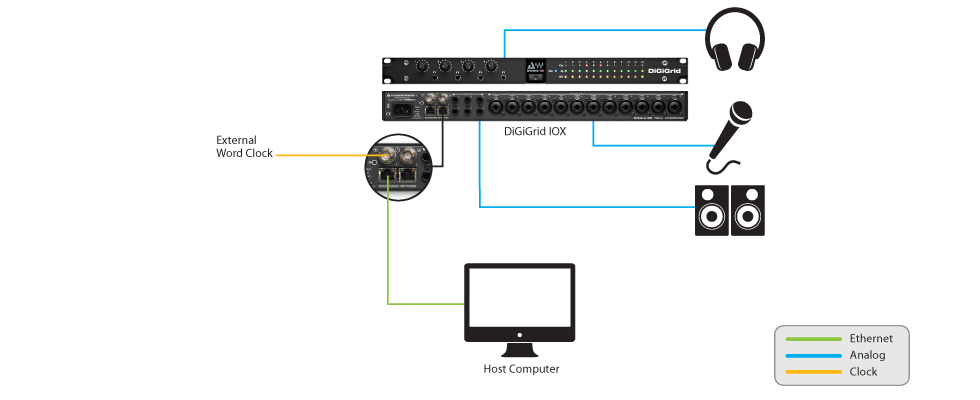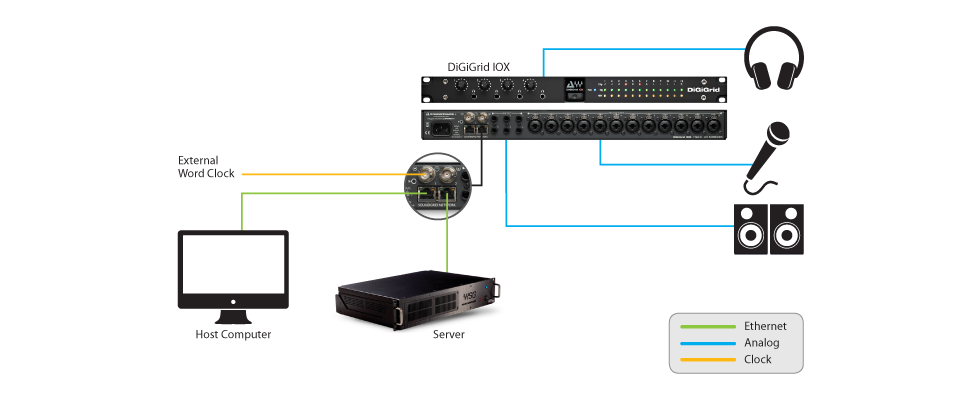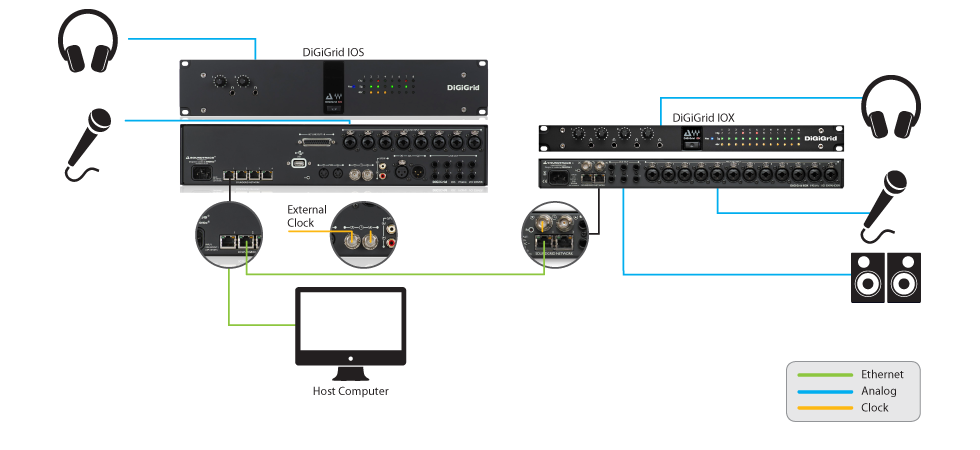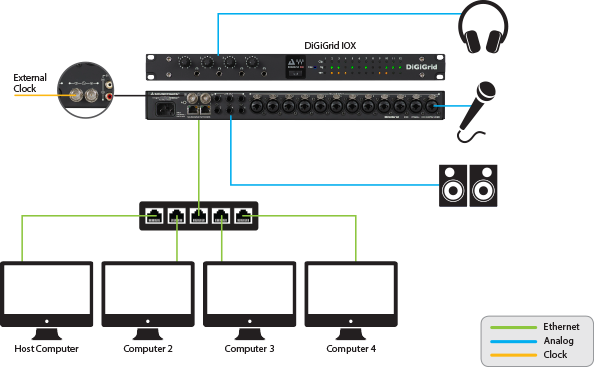Main Features
Ideal for your studio’s performance/recording room, DiGiGrid IOX is a high-count I/O interface featuring 12 mic/line inputs with broadcast/studio-quality preamps and 6 line outputs.
Audio I/O for Native DAWs
12 mic/line inputs with broadcast/studio-quality preamps
6 line outputs, 4 headphone outputs
High-definition 192kHz ADC conversion
Super-low latency: 0.8 milliseconds
Connect with one Ethernet cable (Cat 5e/Cat 6)
Ideal for your studio’s performance/recording room, DiGiGrid IOX is a high-count I/O interface featuring 12 mic/line inputs with broadcast/studio-quality preamps and 6 line outputs. With four customizable headphone outputs which allow individual mixes for each musician, the IOX delivers high-resolution monitoring whether you’re performing in the studio or listening in the control room.
Plug the IOX into your SoundGrid network with a single Ethernet cable, and you will enter a new world of real-time tracking, mixing and monitoring. And that’s not all: With a SoundGrid DSP server on your network, you can run hundreds of SoundGrid-compatible plugins from Waves and other developers, fully integrated within your DAW, with latency of only 0.8 milliseconds.
For a list of hosts compatible with DiGiGrid IOX, click here, then scroll down and check under the Support tab.
Software
The IOX installer includes the relevant drivers and software for your unit: the SoundGrid ASIO/Core Audio driver, the SoundGrid Studio Application, the eMotion ST mixer, StudioRack, and the IOX Control Panel.
- SoundGrid Studio System Software
- SoundGrid Studio Application
- eMotion ST Mixer
- StudioRack
- DiGiGrid IOX Control Panel
DiGiGrid IOX Comes with the Complete SoundGrid Studio System Software by Waves
The SoundGrid Studio System is the next generation of sound technology. It is a real-time processing and networking platform designed to bring your studio up to light speed. It allows your DAW to offload its plugin processing to a SoundGrid DSP server and enables your devices to communicate with one another and with the devices of the people you work with. The SoundGrid Studio System integrates seamlessly with all DAWs and DiGiGrid (or other SoundGrid-compatible) I/Os, providing endless possibilities for setups of every size—from a single DAW with one DiGiGrid I/O, to an entire network of host computers, I/Os, and SoundGrid DSP servers.
The SoundGrid Studio System Gives You the Power to Do More
- Real-Time Processing – Run hundreds of plugins simultaneously.
- Low-Latency Monitoring – Track and rehearse with full-on plugins in near-zero latency.
- Networking – Connect everything and everyone through a centralized hub.
- Seamless Integration – Connect multiple DAWs using the SoundGrid ASIO/Core Audio driver.
- Open Architecture – Compliant with SoundGrid-compatible Waves and third-party plugins.
SoundGrid Studio System Software Components
- SoundGrid Studio Application – For managing the SoundGrid network on your host computer.
- eMotion ST Mixer – Low-latency monitoring for tracking and rehearsing.
- StudioRack – For running plugin chains, saving and loading their presets, and offloading their processing to a SoundGrid DSP server.
- SoundGrid ASIO/Core Audio – Connects any DAW to the SoundGrid network as a software I/O.
The SoundGrid Studio Application is your tool for managing all software and hardware connected to the SoundGrid network. With its dynamic I/O mapping ability, the SoundGrid Studio Application lets you configure your SoundGrid network, manage its various components, and set up any combination of drivers and SoundGrid-compatible devices. It also enables I/O sharing between several computers, allowing you to manage their resources from your host computer.
The SoundGrid Studio Application enables you to:
- Configure your SoundGrid ASIO/Core Audio driver and DiGiGrid I/Os. (Auto-configuration Wizard available.)
- Process, mix and monitor in real time (together with StudioRack and the eMotion ST mixer).
- Connect and patch multiple hardware devices and software I/Os.
- Stream audio from and to multiple host computers running different DAWs.
- Create and save your own configuration templates.
- Control the parameters of your DiGiGrid I/Os (channel input gain, phantom power, etc.).
Learn more about the SoundGrid Studio Application at waves.com »
eMotion ST is the mixer part of the SoundGrid Studio System. Combined with StudioRack, it lets you run SoundGrid plugins for low-latency monitoring, giving you complex monitor mixing options while recording with your DAW.
 |
 |
eMotion ST is a high-quality mixer with 8 multi-purpose inputs, 64 additional StudioRack input channels, 2 FX busses, 6 mix busses, and a main stereo mix. Since the mixer operates within the SoundGrid network, any DiGiGrid I/O or any available SoundGrid-compatible I/O device, whether hardware or driver-based, can provide it with inputs and outputs.
The eMotion ST mixer can run hundreds of Waves and third-party SoundGrid-compatible plugins in low latency, replacing in this respect the external mixer traditionally used to create monitor mixes for studios and headphones.
- 8 multi-purpose mono/stereo input channels
- 2 stereo FX aux buss/returns and 6 stereo aux buss/returns
- Up to 64 mono channel feeds from StudioRack plugins
- 8 insert slots per channel for SoundGrid plugins
- Connects to multiple DiGiGrid I/Os and other SoundGrid-compatible devices and hosts
- Compliant with SoundGrid-compatible Waves and third-party plugins
- Fully integrates with StudioRack
- Enables use of SoundGrid plugins as standalone processors for any purpose
- Requires at least one DiGiGrid I/O and a SoundGrid DSP server
StudioRack is a software rack dedicated to running plugin chains. The processing of each chain can then be directed to your host computer’s CPU or to a SoundGrid DSP server (if present), as you choose. When you process your plugin chains on a SoundGrid server, StudioRack lets you monitor your tracks in extremely low latency via the eMotion ST mixer. StudioRack is compatible with most popular DAWs, with a dedicated component for Pro Tools TDM and HDX systems which enables you to offload your plugin processing to the SoundGrid server if you choose to use one.
- Compatible with most popular DAWs
- Plugin chains are processed on local CPU or SoundGrid DSP server
- Compatible with Pro Tools HD/HDX and HD Native
- Compatible with Waves and third-party plugins
- Enables monitoring in super-low latency
- Up to 8 plugins per rack
- Fully automatable
- Plugin chain presets can be loaded on any DAW as well as on MultiRack and eMotion ST
- Instant access to plugin parameters within each chain
- Intuitive MIDI control over all plugins
- Avid Control Surface support
- Clock settings: source, sample rate, type, status
- Mic preamp controls: input gains, phantom on/off
- Optional sample rate conversion on digital inputs
- Input and output meters
- Save and load presets of unit settings
- Save your settings along with your Waves and SoundGrid host application sessions
Expanded Details
One host computer, DiGiGrid IOX and a SoundGrid DSP server
You probably want to run more plugins. Perhaps you want to record small ensembles and then mix with a large number of plugins, or record and monitor with very low latency.
By adding a SoundGrid DSP server to your SoundGrid network you can offload your audio processing. This greatly increases the number of plugins you can use simultaneously. Plus, it enables you to use the eMotion ST mixer, which lets you create personalized monitor mixes from your DAW mix and from outside sources, and also allows you to open 64 StudioRacks and use them for low-latency monitoring.
- DAW (Pro Tools, Nuendo, Cubase, Logic, etc.) with SoundGrid Studio installed
- High-count input SoundGrid I/O with four headphone outs– DiGiGrid IOX
- SoundGrid DSP Server (DiGiGrid DGS-XL)
One Host Computer, One I/O with a DSP Server, One Expansion I/O Unit, One DAW
Need more I/O channels? Need to run more plugins? need super-low latency recording with plugins in real time?
By adding the IOS-XL’s built-in DSP server to your SoundGrid network you can offload your audio processing. This greatly increases the number of plugins you can use simultaneously. Plus, it enables you to use the eMotion ST mixer, which lets you create personalized monitor mixes from your DAW mix and from outside sources, and also allows you to open 64 StudioRacks and use them for low-latency monitoring.
- DAW (Pro Tools, Nuendo, Cubase, Logic, etc.) with SoundGrid Studio installed
- Multi-input SoundGrid I/O device with server – DiGiGrid IOS-XL
- SoundGrid expansion I/O – DiGiGrid IOX
One host computer, DiGiGrid IOX and a DiGiGrid IOC
Add a DiGiGrid IOC and you pick up another 2 mic inputs, 16 AES inputs and outputs, 8 line inputs and outputs ADAT I/O, and 2more individual headphone outputs. Connect the IOC to the built-in Ethernet switch on the rear of the IOX. You can add up to eight SoundGrid I/O devices to a single host. Each of these can be accessed by any computer on the network.
Audio and clock pass through the same Ethernet cable. This means of distributing clock is called “Sync over Ethernet” (SoE) and isused between all SoundGrid devices. To clock the entire network to an external clock source such as house sync, use Word Clock or Digital In as clock master for the IOX. If the IOX is the SoE master, then the entire network will be locked to this external source.
Running Various DAWs Simultaneously Using a Single DiGiGrid IOX
This configuration is for running audio from multiple DAWs simultaneously and mixing them in real time.
- DiGiGrid IOX
- Host computer with Native DAW
- Computer 2-4 – Native DAWs
- 1 GB network switch
Each of the four computers is connected to the DiGiGrid IOX via a 1 GB network switch using a single Cat 5e or Cat 6 Ethernet cables.
Every computer in a SoundGrid network uses the SoundGrid driver to stream audio into the SoundGrid network. In this setup the main host computer running the SoundGrid Studio Application patches between all host computers within the network and configures their ASIO/Core Audio driver ins and outs.
General
- 1U rack-mounted (standard 19” rack-mount wide, 4U high, 380-mm deep excluding connectors)
- Supported sample rates: 44.1, 48, 88.2 and 96 kHz (176.4 and 192 kHz will be supported in the future)
- 12 channel mic/line inputs (on XLR/TRS combo)
- 6 channel line outputs
- Word Clock I/O
- 2 SoundGrid ports (RJ45s)
- Reset switch
- 4 headphone outputs with analog level knobs; range: Off to +15 dB
- Clock: Word Clock input, SoundGrid (SoE), Internal
- AC input
- Multiple broadcast level format settings (jumpers on all analog I/Os)
Analog Inputs
- Input Impedance: Mic: 2K5 / Line: 8K0 Ohms
- Gain Range: Mic: 0 dB to +52.5 dB in 7.5-dB steps / Line: -10 dB to +42.5 dB in 7.5-dB steps
- Fine control provides an additional 0dB to 7dB in 0.5-dB steps
- Maximum Input Level: Mic: +26 dBu / Line: +36 dBu
- Mic Equivalent Input Noise: > -126 dB (150 Ohm source, gain +59.5 dB)
- Harmonic Distortion: Typically < 0.01% @ unity gain, -10dB input @ 1 kHz
- Frequency Response: +/-0.5 dB (20 Hz to 20 kHz)
- Channel Separation: Better than 90 dB (40 Hz to 15 kHz)
Analog Outputs
- Maximum Output Level: +22 dBu
- Residual Output Noise: <90 dB (20 Hz to 20 kHz)
- Frequency Response: +/-0.5 dB (20 Hz to 20 kHz)
- Output Impedance: 50 Ohms
- Channel Separation: Better than 90 dB (40 Hz to 15 kHz)
- Harmonic Distortion: Typically < 0.01% @ unity gain, -10dB input @ 1 kHz
Weight and Dimensions
| Height | Width | Depth | Weight |
| 1U / 43.6mm | 19″ / 482.60 mm | 356 | 4.5Kg |
One host computer, DiGiGrid IOX and a SoundGrid DSP server
You probably want to run more plugins. Perhaps you want to record small ensembles and then mix with a large number of plugins, or record and monitor with very low latency.
By adding a SoundGrid DSP server to your SoundGrid network you can offload your audio processing. This greatly increases the number of plugins you can use simultaneously. Plus, it enables you to use the eMotion ST mixer, which lets you create personalized monitor mixes from your DAW mix and from outside sources, and also allows you to open 64 StudioRacks and use them for low-latency monitoring.
- DAW (Pro Tools, Nuendo, Cubase, Logic, etc.) with SoundGrid Studio installed
- High-count input SoundGrid I/O with four headphone outs– DiGiGrid IOX
- SoundGrid DSP Server
One Host Computer, One I/O with a DSP Server, One Expansion I/O Unit, One DAW
Need more I/O channels? Need to run more plugins? need super-low latency recording with plugins in real time?
By adding the IOS’s built-in DSP server to your SoundGrid network you can offload your audio processing. This greatly increases the number of plugins you can use simultaneously. Plus, it enables you to use the eMotion ST mixer, which lets you create personalized monitor mixes from your DAW mix and from outside sources, and also allows you to open 64 StudioRacks and use them for low-latency monitoring.
- DAW (Pro Tools, Nuendo, Cubase, Logic, etc.) with SoundGrid Studio installed
- Multi-input SoundGrid I/O device with server – DiGiGrid IOS
- SoundGrid expansion I/O – DiGiGrid IOX
One host computer, DiGiGrid IOX and a DiGiGrid IOC
Add a DiGiGrid IOC and you pick up another 2 mic inputs, 16 AES inputs and outputs, 8 line inputs and outputs ADAT I/O, and 2more individual headphone outputs. Connect the IOC to the built-in Ethernet switch on the rear of the IOX. You can add up to eightSoundGrid I/O devices to a single host. Each of these can be accessed by any computer on the network.
Audio and clock pass through the same Ethernet cable. This means of distributing clock is called “Sync over Ethernet” (SoE) and isused between all SoundGrid devices. To clock the entire network to an external clock source such as house sync, use Word Clock or Digital In as clock master for the IOX. If the IOX is the SoE master, then the entire network will be locked to this external source.
Running Various DAWs Simultaneously Using a Single DiGiGrid IOX
This configuration is for running audio from multiple DAWs simultaneously and mixing them in real time.
- DiGiGrid IOX
- Host computer with Native DAW
- Computer 2-4 – Native DAWs
- 1 GB network switch
Each of the four computers is connected to the DiGiGrid IOX via a 1 GB network switch using a single Cat 5e or Cat 6 Ethernet cables.
Every computer in a SoundGrid network uses the SoundGrid driver to stream audio into the SoundGrid network. In this setup the main host computer running the SoundGrid Studio Application patches between all host computers within the network and configures their ASIO/Core Audio driver ins and outs.
General
- 1U rack-mounted (standard 19” rack-mount wide, 4U high, 380-mm deep excluding connectors)
- Supported sample rates: 44.1, 48, 88.2 and 96 kHz (176.4 and 192 kHz will be supported in the future)
- 12 channel mic/line inputs (on XLR/TRS combo)
- 6 channel line outputs
- Word Clock I/O
- 2 SoundGrid ports (RJ45s)
- Reset switch
- 4 headphone outputs with analog level knobs; range: Off to +15 dB
- Clock: Word Clock input, SoundGrid (SoE), Internal
- AC input
- Multiple broadcast level format settings (jumpers on all analog I/Os)
Analog Inputs
- Input Impedance: Mic: 2K5 / Line: 8K0 Ohms
- Gain Range: Mic: 0 dB to +52.5 dB in 7.5-dB steps / Line: -10 dB to +42.5 dB in 7.5-dB steps
- Fine control provides an additional 0dB to 7dB in 0.5-dB steps
- Maximum Input Level: Mic: +26 dBu / Line: +36 dBu
- Mic Equivalent Input Noise: > -126 dB (150 Ohm source, gain +59.5 dB)
- Harmonic Distortion: Typically < 0.01% @ unity gain, -10dB input @ 1 kHz
- Frequency Response: +/-0.5 dB (20 Hz to 20 kHz)
- Channel Separation: Better than 90 dB (40 Hz to 15 kHz)
Analog Outputs
- Maximum Output Level: +22 dBu
- Residual Output Noise: <90 dB (20 Hz to 20 kHz)
- Frequency Response: +/-0.5 dB (20 Hz to 20 kHz)
- Output Impedance: 50 Ohms
- Channel Separation: Better than 90 dB (40 Hz to 15 kHz)
- Harmonic Distortion: Typically < 0.01% @ unity gain, -10dB input @ 1 kHz
Weight and Dimensions
- Height: 1U / 43.6mm
- Width: 19″ / 482.60mm
- Depth: 356mm
- Weight: 4.5Kg
Download the DiGiGrid Brochure
Click below to download the latest copy of our brochure. See all we have to offer and more.
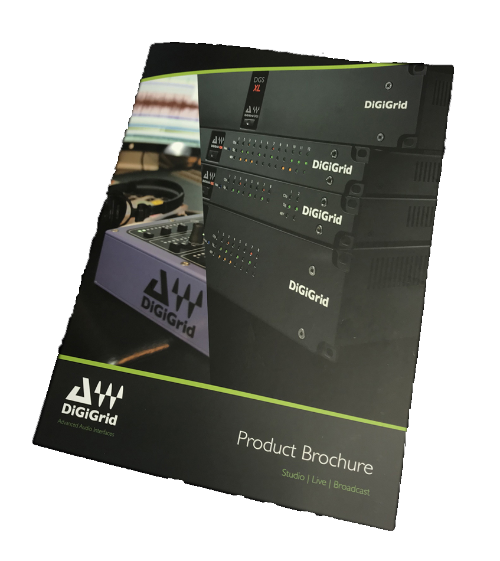
Related Products
Please see below for other products in our range.

DiGiGrid IOS-XL

DiGiGrid DLI

DiGiGrid IOC
News & Updates
Sign up to our monthly newsletter and recieve up to date
information on new products and special offers.





